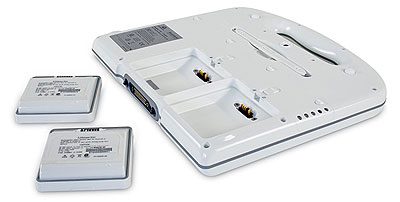On March 4, 2009 TabletKiosk joined the growing number of companies offering medical slates based on Intel's mobile clinical assistant reference architecture. The TabletKiosk MediSlate MCA i1040XT closely follows Intel's original proof of concept platform with its clipboard form factor, lightweight design, and integrated handle for easy use and carrying during a work shift.

TabletKiosk's new slate is a very timely entry into a market that may well see very significant growth over the next few years as the US Federal Economic Stimulus legislation that passed Congress and was signed by President Obama in February 2009 includes almost US$20 billion to modernize health care systems with the goal of switching to electronic patient records for all Americans by the year 2014. This means there's plenty of potential business, but TabletKiosk is also entering a market where the competition has a significant head start. Motion Computing entered the MCA market two years ago with their C5 Mobile Clinical Assistant, a machine that's been quite well received. The Panasonic H1 Mobile Clinical Assistant was introduced in November 2008, drawing on Panasonic's vast resources. Fujitsu is testing the market with the Esprimo MA "Personal Healthcare Assistant", and embedded and industrial systems specialist Advantech has the Atom-based MICA-101. What does TabletKiosk have to offer going against such formidable competition?
The form factor and overall implementation is pretty much determined by Intel's original reference design, and the i1040XT complies with a slate that measures 10.6 x 10.1 inches and is 1.4 inches thick. It weighs 3.25 pounds including batteries, and has the integrated carry handle Intel felt an MCA should have.
Since MCAs are meant to improve workflow, ease workloads, and reduce errors, Intel mandated the inclusion of a variety of data capture technologies. The TabletKiosk machine has an integrated 2D/1D barcode scanner, a 13.56MHz RFID reader with ISO 14443A/B and ISO 15693 support, a biometric fingerprint reader, and also a 2-megapixel web-enabled camera that can also capture video.
On the technology side of things, the i1040XT uses a 1.06GHz Intel Core 2 Solo U2100 ULV processor, an ultra low power chip with a maximum thermal design power of 5.5 watts. The machine comes with a generous 2GB of DDR2 SDRAM, a shock-mounted 4,200rpm 80GB 1.8-inch SATA hard disk, and a 10.4-inch TFT touch screen display with 1024 x 768 pixel XGA resolution. There's 802.11a/b/g/n WiFi, Bluetooth 2.1 + EDR, and an optional WWAN module.

Now what about the design? TabletKiosk refers to a "specially sealed, semi-rugged, smooth surface case that is drop-resistant and spill-proof enabling it to be easily wiped clean and disinfected to help reduce the spread of germs." The statement really covers two areas that a mobile clinical assistant must fulfill: a degree of ruggedness so it won't break under typical working conditions in a clinical environment, and a design that facilitates easy cleaning and disinfection. Infection control is a major issue in clinical settings, and mandates frequent spraying and wiping of the unit with disinfectant. How did TabletKiosk address those requirements?
The i1040XT is described as "semi-rugged" with the following specs:
- 4 foot drop
- Enclosure resists alcohol (80% or less), bleach, iodine and common hospital disinfectants
- IP54 sealing
- Shock-mounted disk or optional SSD
How does the i1040XT compare to the competition? There are some pros and cons. The i1040XT has a clean, sleek design and closely follows the requirements of Intel's reference architecture. We like the dual battery approach that enables hot-swappable operation when away from the dock. In this day and age of cheap memory we like that TabletKiosk offers even the base machine with 2GB of RAM. And the claimed 4-foot drop spec exceeds the competition.
TabletKiosk, however, missed in several other areas. While the Intel Core 2 Solo is a competent processor, the competition mostly uses the newer and more power-efficient Atom z5xx chips that have much lower thermal design power and run cooler. As a result, battery life (up to 4.5 hours) is good, but not great. While the i1040XT offers anti-glare treatment and claims daylight readability, its LED backlight maxes out at 240 nits—a tough sell against Motion's superb View Anywhere screen and Panasonic's very bright 500 nit display. In terms of operation, the i1040XT exclusively relies on a resistive touchscreen whereas the competition offers either electromagnetic digitizers or both touch and active digitizers. Offering touch only in an environment where minimal contamination matters is not a good choice. And while TabletKiosk claims the i104XT is easy to clean, there are quite a few slots and holes where bacteria can hide, and the screw holes are not covered as they are in competing designs.
The starting price of the TabletKiosk i1040XT is US$2,799. That is quite high compared to Motion's base model C5 (US$2,199) which has a faster processor and offers more configuration choices, or the Panasonic H1 which offers a brighter display, longer battery life and a dual digitizer at the same starting price. It's good to have TabletKiosk join this market, but from a newcomer we'd expect better design and technology or a lower price, and as of now we're not seeing either.



